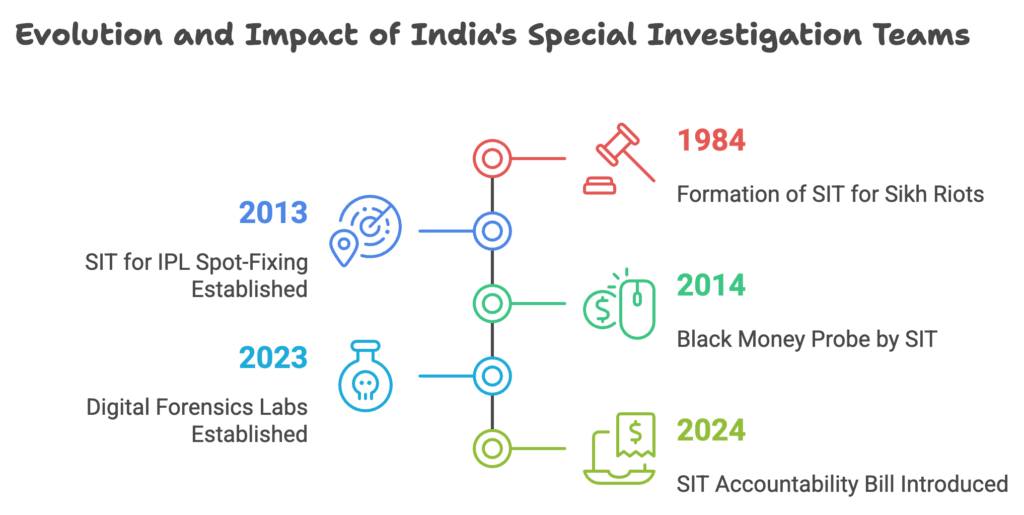
Courses

By Shailendra Singh
|
Updated on 8 Apr 2025, 12:02 IST
The Special Investigation Team (SIT) is a critical component of India’s criminal justice framework, designed to handle high-profile or complex cases requiring impartial oversight. This guide breaks down its functions, formation, and significance in simple terms for beginners, while incorporating insights from authoritative sources to ensure accuracy and depth.
SIT Full Form: Special Investigation Team
Primary Purpose: To conduct unbiased investigations in cases where existing agencies face challenges due to political influence, resource constraints, or procedural complexities.
Unlike permanent agencies like the CBI, SITs are temporary task forces constituted for specific cases. They dissolve after submitting their final report to the appointing authority.
SITs derive authority from:
Example: The 2013 IPL spot-fixing SIT comprised retired Justice Mukul Mudgal, two senior police officers, and a financial forensic analyst.
Workflow Stages
| Case Name | Year | Key Outcomes | Significance |
| 1984 Sikh Riots | 2005 | Conviction of 16 accused after 21 years | Established SIT as a delayed justice mechanism |
| IPL Spot-Fixing | 2013 | Lifetime ban on 3 cricketers | Exposed sports corruption networks |
| Gujarat Riots | 2008 | 120 convictions across 9 major cases | Highlighted communal violence accountability |
| Black Money Probe | 2014 | ₹14,000 crore tax evasion identified | Pioneered financial forensics in SITs |
| Parameter | SIT | CBI |
| Authority | Temporary judicial/executive order | Permanent statutory body (DPSE Act) |
| Jurisdiction | Case-specific | Nationwide |
| Leadership | Retired judges | IPS officers |
| Duration | Dissolves post-investigation | Permanent |
| Focus | Single high-profile case | Diverse criminal matters |

Recent Developments (2023–2025)
The SIT Full Form The Special Investigation Team remains India’s premier mechanism for ensuring justice in politically sensitive or complex cases. While challenges persist, its evolving framework—from the 1984 riot probes to contemporary crypto-crime investigations—demonstrates adaptability. For beginners, understanding SIT’s role illuminates the delicate balance between judicial oversight and executive authority in India’s democracy.
Key Takeaways:

SIT stands for Special Investigation Team, a temporary law enforcement body appointed for high-profile and complex cases.
SITs are formed by the Supreme Court, High Court, or Government when an impartial and expert investigation is needed.
SIT investigates corruption, violent crimes, financial fraud, terrorism, and political scandals requiring special expertise.
SIT is case-specific and temporary, while CBI is a permanent agency handling national and international crimes.
Ans: SIT stands for "Special Investigation Team." It is a dedicated group of law enforcement officers and experts assembled to conduct detailed and impartial investigations into specific cases that are often complex, high-profile, or have far-reaching implications. In Hindi, SIT is known as "विशेष जांच दल" (Vishesh Jaanch Dal).
Ans: Special Investigation Teams are formed for several critical purposes:
Ans: SITs can be created by:
The authority to form an SIT comes from compliance with the Indian Penal Code of 1860, and they are typically appointed during urgent emergency situations requiring special attention.
Ans: SIT investigations are typically led by senior police officers of high rank. For instance, in the Kotkapura police firing case mentioned in the search results, the SIT was headed by ADGP L K Yadav. SITs are generally headed by an independent committee of outstanding investigators authorized by extrajudicial authority.
Ans: SIT members are selected based on their expertise and experience relevant to the case under investigation. The composition typically includes:
Ans: SITs are granted powers to:
Ans: Based on the information available, typical SIT investigation stages include:
Ans: Yes, time limits can be imposed on SIT investigations. For example, in the Kotkapura police firing case, the Punjab and Haryana High Court set a six-month timeframe for the SIT to conclude its investigation. However, this was an upper limit, and the SIT was free to complete the investigation earlier if possible. The specific timeframe depends on the complexity of the case and the directives of the appointing authority.
Ans: While not explicitly detailed in the search results, based on the information provided, after an SIT submits its report:
Ans: While the search results mention that the 1984 Delhi riots was one of the most famous cases handled by an SIT, specific details about the outcome of this investigation are not provided in the given information.
Ans: According to the information available, SITs have faced criticism in the past for failing to reach conclusions in some cases due to political pressures. However, they continue to be formed for complex and sensitive investigations, suggesting that they remain an important mechanism in the Indian justice system.
Ans: Key differences between SIT and CBI include:
Ans: Based on the information provided, SITs are typically formed to cooperate with existing state police. While they have a degree of independence and autonomy, they work within the framework of the legal system. The search results don't explicitly state that SITs can override regular police investigations, but they are often formed when regular police investigations are deemed insufficient or require special attention.
Ans: One example from the search results is the Supreme Court upholding the Bombay High Court order that directed the CBI to form a special investigation team for probing the Rs. 2,434 crore Jai Corp fraud case.
Ans: Based on the information provided, SITs face several challenges: